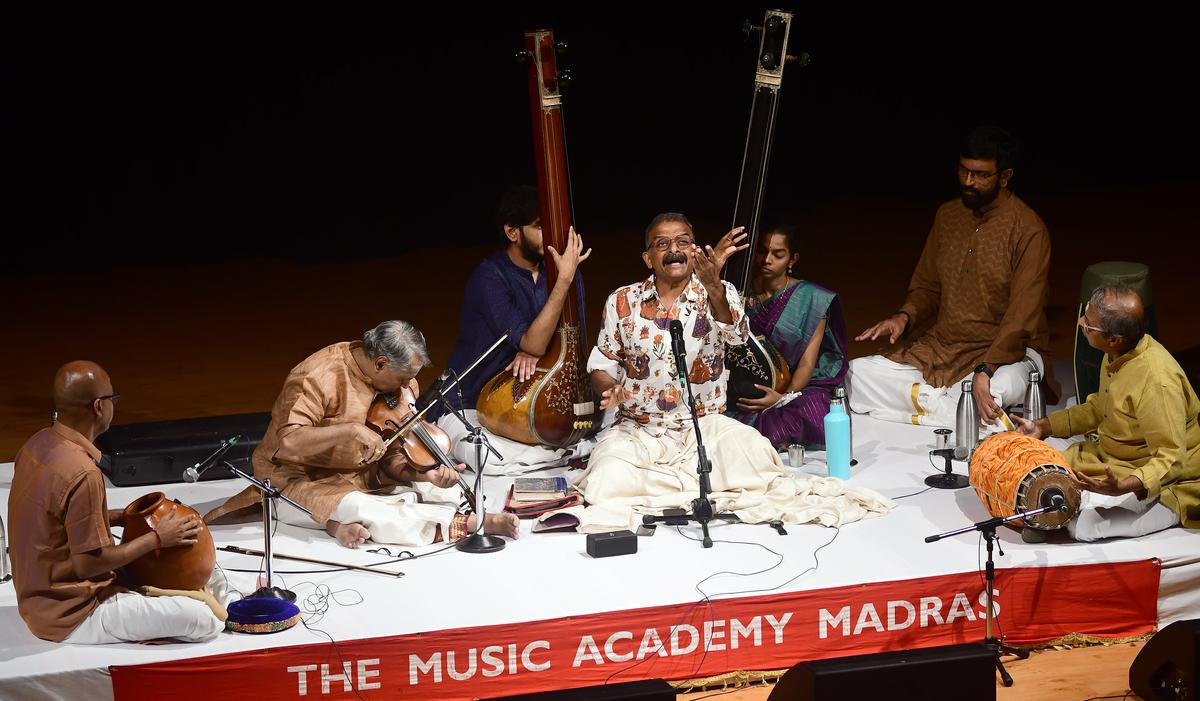
T.M. Krishna rendering specially curated kritis at the Tyagaraja Aradhana concert that took place at the Music Academy on February 4, 2024.
| Photo Credit: K. Pichumani
They waited. Silently. Patiently. With hopes that they could listen to the glorious music of yore. T.M. Krishna was going to sing at the Music Academy as part of Tyagaraja Aradhana, after a hiatus. The homage was open to all and a capacity crowd filled the hall.
Accompanied by his friends of decades, Krishna opened the concert with the sombre strains of Mukhari followed by the rare kriti ‘Muripemu kalige gada Rama’ ( Haven’t you become a little proud , O Rama?) While the raga was expansive at a leisurely pace, the niraval and the madhyama kala swara were capped by an upward spiralling movement. As this opening sequence lasted more than 30 minutes, with never a dull moment or a cliched phrase, the alapana of Varali that followed caused some uneasiness among the listeners. Was the evening going to be long and sombre?
Krishna’s alapana was almost a soul-searching journey in its intensity, and at the top strains when he burst forth with the anu pallavi ‘Eti janmam ithi’ (What kind of birth is this!), it seemed a re-creation of the moment of inspiration that made Tyagaraja cry out in despair. The niraval for the phrase ‘Sagara Sayanuni’ sustained the mood of the song and was not marred by an exercise in swaraprasthara.
A bright and brisk ‘Chinna nade na cheyi batti thive’ (Right in my youth you took my hand and promised to take care of me) came as a fresh breath of air. A masterpiece in the hands of flute maestro Mali, this song is not often heard these days. In the charanam, Tyagaraja wonders if Rama is pondering on whether to abandon or accept him and he pleads with Rama to protect his honour. The brief alapana of the ragam Kalanidhi that preceded the song sparkled in the deft and aesthetic weaving of the two disjointed halves of the arohanam.

T.M. Krishna with R.K. Shriramkumar on the violin, K. Arun Prakash on the mridangam and N. Guruprasad on the ghatam. He presented a special Tyagaraja aradhana concert at the Music Academy on February 4, 2024.
| Photo Credit:
K. Pichumani
Violinist R.K.Shriramkumar opened with the alapana of Mayamalavagowla as a prelude to ‘Devi thulasamma’. Rooted in tradition, his exposition placed the raga on solid ground for him to build a classical edifice.
Krishna revels in Harikamboji, and the alapana found him in his element. A brisk paced ‘Chani thodi theve’ added pep and set the pace for the thani by mridangist Arun Prakash and ghatam artiste Guruprasad, who worked the tempo to advantage and played a riveting dialogue. While accompanying the songs, Arun Prakash, as always, moved from silence to whisper and murmur, and his imperceptible build to a crescendo in the charanam provided a joyous bounce to the lyrics.
Soon, high drama set in with ‘Chede buddhi maanura’ (O mind, give up the bad ways). Atana, the raga of varied hues, took on a stentorian countenance and every repetition of the word ‘Chede’ (bad) was a whiplash of censure. The fast-paced swarams carried the drama to its climax.
‘Dwaithamu sukhama’ in reposeful Reethigowlai came as oil on troubled and turbulent waters. Krishna’s commencement of a raga sounds like he’s looking for a phrase that occurs at the moment, to latch on to. Often, the violin treads a cautious path, never straying into any note that would suggest a raga. So it was, before Krishna chose to settle for Reethigowla. The note-perfect rendering of Semmangudi’s majestic pathantaram sailed forth like a stately ship.
Tyagaraja’s ‘Narayana Hari Narayana Hari’ in Yamuna Kalyani fell as gentle rain from heaven as the fleeting alapana prelude soothed the spirits. The Pallavi of the keerthanam is a chant in the Nama Sankeerthanam tradition, whereas the charanams denounce the materialism and petty mindedness of the people around. The composer declares that he has no desire for material wealth, nor would he flatter the affluent for favours.
The Suruti alapana announced the finale, and the traditional closing number ‘Geetharthamu Sangeethaanandamu’. Here, Tyagaraja avows that the meaning of the Gita and the bliss of music are both perceived in Rama. A slow-paced rendering of the mangalam ‘Nee nama roopamulaku’, and its several stanzas reminiscent of M.D. Ramanathan, concluded the concert on a note that spelt calm.